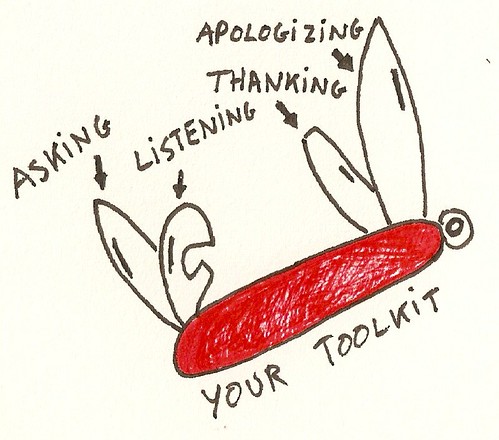In this part we focus on what it takes for you and I to equilibrate a relationship. A Phd in psychology? None of that! We need to realize that all we need to balance relationships is always available to us. It’s like a Swiss Armyknife we carry around all the time.
Keeping You In The Loop
Before starting the seventh part of this series, have a look at the summary of the 6 previous articles below:
Part 1: The situation we are in determines the roles we play and the rules we follow; and we reciprocate every request with a response. We also saw that each situation determines the face-value that we can claim for ourselves. The face-value comes with the situation and it is scripted in our roles.
Part 2: The way human interaction actually works is through the constant exchange of social currency (love, attention, acknowledgement, etc). In the end, human interaction can easily be summarized as a series of “+1″ and “-1″ in order to equilibrate the face-values that have been claimed. We build and deepen relationships through cycles of testing and response. Building a relationship can be compared to making deposits of empathy (the exchange of “+1″) on the emotional bank account of trust.
Part 3: In the same way as our reciprocity-reflex forces us to equilibrate the “+1″ and the “-1″ statuses of a situation, we have another reflex: the chameleon-like tendency to resonate with the influences of a situation.
Part 4: The PDI (Power Distance Index) of the culture you are from determines what the “+1″ and the “-1″ exactly are worth to you. It turns out that formality provides a system of calibration when cultural differences are too big. You can think of formality as the use of a single currency (like the Dollar or the Euro) in order to make the transaction safer between parties from different cultures.
Part 5: In digital communications the same rules and laws of gravity apply, but we lack non-verbal cues of feedback. Therefore the best strategy is to rely on “connection” instead of “control” in order to equilibrate relationships.
Part 6: With the help of Transactional Analysis we can separate transactions that increase the tension in a relationship (and thus decrease the level of trust) from those that equilibrate it (the adult response). A second learning from Transactional Analysis is that ‘games people play’ are powerful dynamics causing people to behave very chameleon-like in certain situations.
The Helping Relationship
Since the beginning of the series I have been referring to Edgar Schein’s book Helping: How to Offer, Give, and Receive Help. By now you will have noted that I consider this book an absolute must-read for any organizational change practitioner. Consider the following thought every time you are in a meeting with a customer:
Emotionally and socially, when you are asking for help you are putting yourself “one down”. It is a temporary loss of status and self-esteem not to know what to do next or to be unable to do it. It is a loss of independence to have someone else advise you, heal you, minister you, help you up, support you, even serve you.
Chances are that you will start to develop a different opinion on what resistance is. According to Shein, every helping relationship is in a state of imbalance. The person being helped is “one down” and therefore vulnerable. The helper is “one up” and therefore powerful. Much of what goes wrong in the helping process is the failure to acknowledge this initial imbalance and deal with it:
The reason the helping relationship has to be built rather than just being assumed is that , although the imbalance is clear, the social economics of how to fix it are not.
It is when a relationship or team hits a bump, we need a conversation about the conversation. But most of the times we short-cut to the content. In the end we wonder what on earth went wrong… The answer: we failed to focus on the relationship. Worse: we did not make use of our personal toolkit.
Becoming Aware of Your Personal Toolkit
Taking care of the relationship is too simple to be true, because the tools at your disposal are as straightforward as a Swiss Armyknife. The knife below displays the tools that are available to all of us – all the time. I repeat: ALL-OF-US and ALL-THE-TIME. The knife is the ultimate relationship equilibration tool.
Asking for help: Peter Drucker once said:
The leader of the past may have been a person who knows how to tell, but the leader of the future will be a person who knows how to ask.
Asking for help opens doors with honesty and is difficult to resist. It allows your counterpart to have a stake in the solution – to ‘win’ – while you are the cause for this situation to occur.
Listening – or rather, the act of acknowledging: listening is a two-way act, as it involves listening AND acknowledging what you have understood. You need to demonstrate that you are totally engaged. Acknowledging is the part that makes people feel understood and connected.
Thanking: Gratitude is a skill we can never display too often. And yet for most people it seems like they need to wait for the perfect moment … but it never comes. It is always the right time to say ‘thank you’. Gratitude is not a limited resource and an overdose never harms.
Apologizing: Marshall Goldsmith calls this ‘the magic move‘, because an apology is a recognition that mistakes have been made and it contains an intention to change for the better. But most of all, an apology is an emotional contact with the people you care about. It is a disclosure which lets you move forward.
You will note that these four ways have one thing in common: they require you to be humble and to position yourself ‘one down’ with regards to the person you are talking to. As Goldsmith concludes:
When you declare your dependence on others, they usually agree to help.
It’s a very awkward feeling when you start to use this toolbox for the first time, because the one-downness makes you more vulnerable. You are deliberately giving away control over the situation. However, by doing so it is clear that you are managing the balance and the reciprocation of the relationship.
In the end, there is nothing more powerful than that. And nothing is more difficult than that, because it requires us to let go of something that is so deeply wired into our reptile brains, i.e.: the need to be in control of a situation.
Series Navigation
<< Unraveling Social Interaction (part 6)




